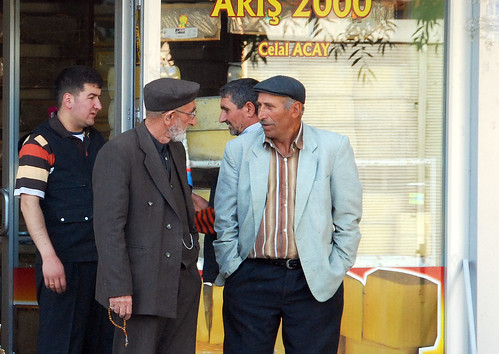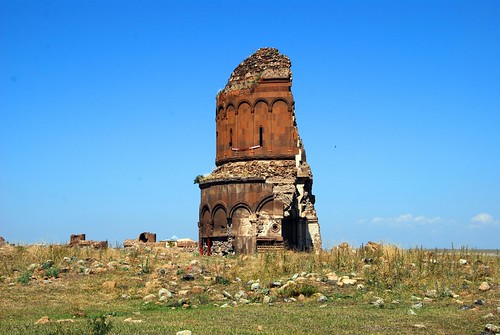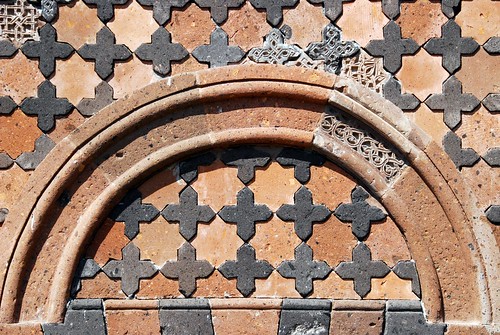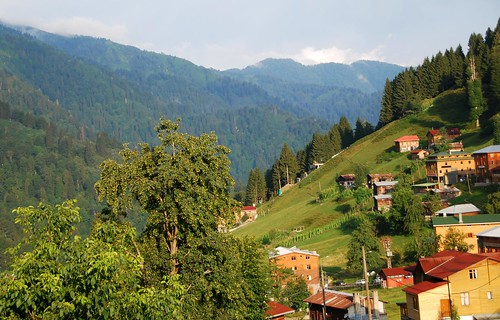Posts Tagged ‘The Black Sea and Northeastern Anatolia’
There comes a time in every travel blogger’s life where you fall behind on your blog (four months in our case). And there comes a time when something so unexpected happens—something so amazing that it manages to infuse your cynical spirit with pure faith in the goodness of this world—that you feel like you can’t possibly wait four months to tell the world about it. This is one of those times.
Van is a town in southeast Turkey, set on the eastern shore of Turkey’s largest lake (called, fittingly, Lake Van).
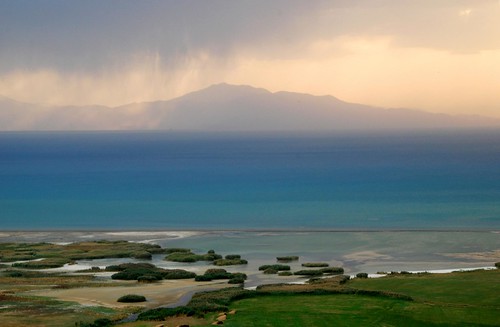
Storm over Lake Van. The lake is so large, some Turks refer to it as a sea.
At this point in our journey, we’ve learned a few lessons about traveling Eastern Turkey:
1. All the information in our guidebook is at best incomplete, and at worst incorrect
2. Nobody speaks English
Sure, this makes things like finding a hotel and getting around more complicated, but not insurmountable. But you know what is kind of hopeless? Trying to remain anonymous, even in a big town, because:
3. Everybody—and I mean EVERYBODY—will stare at you (if “you” happen to be an Asian woman)
Not in an aggressive way, and not in a judgmental way, but in a very, very curious way. If you ever wanted to know what it’s like to live the life of a bacterium under a slide, visit Van, Turkey.
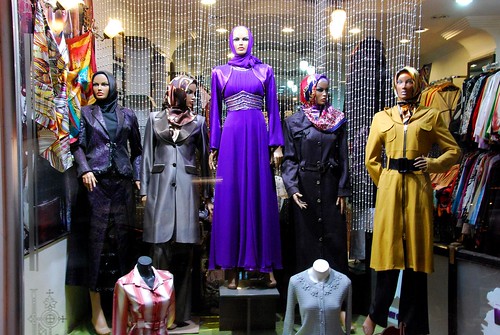
Am I being paranoid, or is she staring at me too?!?
One day, J and I decided to head out to tiny Akdamar Island in the middle of Lake Van, where there is a small but beautiful Armenian church. The ferry to Akdamar leaves from a point on the lake shore about 45 minutes away from Van. All we had to do was to find the bus to the ferry, but given lessons #1 and 2 of traveling in eastern Turkey, this was easier said than done.
On our way to the bus, we ran into a hotel owner who informs us that the bus stop for Akdamar has changed. He helpfully points “over there” to show us the location of the current bus stop, and we head on our way. Having walked about 15 minutes without seeing any buses, we ask some guys on the street. They also point “over there.” More walking. No buses.
We stop at a little cafe and ask directions. Some kids at the cafe overhear us and invite us to sit down and wait while they finish up their tea and snacks. Despite the language barrier, we understand that they will walk us to the bus station. But when we leave, they start walking in the direction we came from. We try to communicate that the bus stop has changed, but this is not getting across. We try one more time, pointing in the opposite direction. No dice. More desperate pointing. More walking in the other direction. Remember how I said lessons #1 & 2 made things “difficult”?
Eventually, we run into two of their friends on the street. One of them speaks English, so we explain our situation to him. He tells his friends that they have been walking us the wrong way, and a flurry of Turkish conversation ensues. And then:
English-speaking guy: My name is Mustafa. This is my friend Ozgur. We are going to take you to the bus station. And then we will take you to Akdamar. We will spend the rest of the day with you.
H + J: Wha? You don’t need to do that! You can just show us the bus stop. We can go on from there.
Mustafa: Turkish people love visitors. We want you to have a good time in our country. Ozgur and I will stay with you.
H + J: Are you sure?!? You really don’t have to do that…we can go on our own.
Mustafa: We want to. Come on, let’s go.
So this is how we ended up spending the day with Mustafa and Ozgur. They took us to the bus stop. They paid for our buses. They found another party at the dock to go out on the boat with us (the ferry does not run unless there are 10 people minimum). They spent their entire Sunday wandering around an island they have probably been to at least 30 times in their lives. They did this in the hot sun. During Ramazan. When they couldn’t drink any water.

Four new buddies on Akdamar Island: Ozgur, Jeremy, Mustafa, and Hope.
When was the last time someone asked you for directions and you not only took them to their destination, but you spent your entire Sunday with them AND paid for their buses? And then you thanked THEM at the end of the day for “giving you something to do during Ramazan.” I’m guessing, oh, NEVER. We were astonished by the generosity that Mustafa and Ozgur showed us.
But wait, there’s more! The next day, we head to Van Castle at sunset, with its sweeping vistas over Lake Van and bird’s eye view of the old ruined city of Van.

Jeremy, exploring the ruins of Van Castle (with Van Lake in the background).
And this is where we met Nevaf, who gave us a ride back to town in the middle of a crazy dust storm, took us out to dinner at a restaurant that Mustafa recommended the day before, and then invited us to drink beers (unlike many Turks, he is Christian) on the shore of Lake Van as the dark fell on our final night in Turkey.

Incredible sunset over Lake Van.
So, wow…Van. Sure, the Church of the Holy Cross on Akdamar was very beautiful.
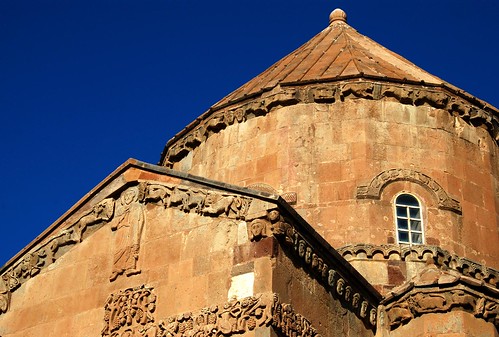
Detail of the Church of the Holy Cross on Akdamar Island. It is covered with gorgeous stone carvings on the outside and religious murals on the inside.
And we’ll never forget watching that sunset from the top of Van Castle.

Gorgeous sunset light framed by the ruins of Van Castle.
But we’ll always have a special little warm feeling in our hearts whenever we think of Van…and that is because of the generosity of both time and spirit shown to us by three Turkish friends. Thank you, Mustafa, Ozgur, and Nevaf, for showing us what true Turkish hospitality is all about.
Transportation from Kars to Van: Our bus ride from Kars to Van was so painless I can’t even remember it. Nice to have some of those every once in a while. 30 TL (US$20) per person.
Where we slept in Van: In a town with only a few budget options, Otel Bahar (right next to the big green mosque) delivers. Clean, spacious rooms, nice views of the mosque on the upper floors, central location, and free wi-fi. 50 TL (US$33) for a double room ensuite.
As an around-the-world traveler, you tend to hear a lot of the same questions: What are your favorite countries? How much does a trip like this cost? Where do you do your laundry? But every once in a while, you’ll get a query that really stops and makes you think. Do you become blasé about amazing sights because you see them every day?
Well shoot, that’s a good question. Do we?!?
I’ll admit that some of the places we’ve visited have not seemed as impressive as they would have had we visited under different circumstances. I’m sure I would have been blown away by Ephesus or Krabi or Xian had we visited straight from SF.
But we’ll get back to that in a second. For now, let’s cut to Ani, the former capital of Armenia. Ani is a site in eastern Turkey that is literally yards away from the Armenian border.
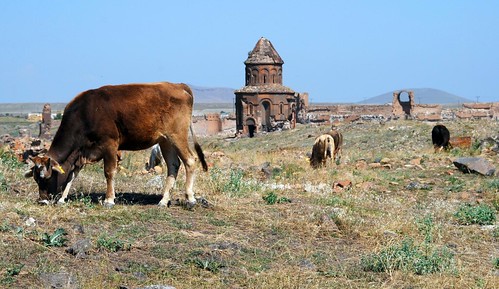
Cattle worshipping at the Church of St. Gregory in Ani.
The closest town to Ani is Kars and frankly, there is not much reason to go there except to visit Ani. A run-down, Soviet-style town, Kars is pretty far off Turkey’s beaten path…so much so that within an hour of getting off the bus, the guy who is mentioned in our Lonely Planet as a reliable guide finds us, along with pretty much every other tourist in Kars (there were 10 of us). Still, Kars grew on us, despite the dilapidated buildings and the uninteresting city plan (a Soviet-style grid).
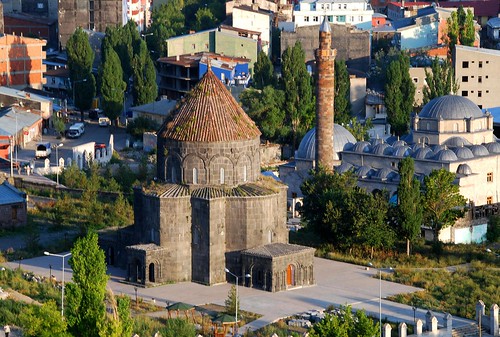
Bird’s eye view of the Armenian-style church and mosque in Kars.
It’s a 1.5 hour long ride to Ani from Kars, and the 10 of us tourists hopped in a van to visit these Armenian ruins. Along the way, we got to know our fellow travelers: 4 older Brits, an American, a Spanish guy, and a couple from Switzerland. And despite the fact that Jeremy and I were a bit “ruined out” at this point in our Turkey travels, we were still excited to be visiting Armenian-style ruins that so few visitors to Turkey get to see (indeed, our bus contained the only visitors to Ani that day). We pay our 5 TL entrance fee and wander through the old city walls:
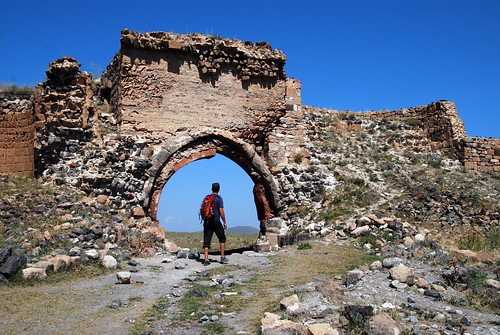
Jeremy framed by the old city walls.
And this is when the Spanish guy says:
“Ahhh! This is SHIT!”
Uh, excuse me, Spanish guy? Really?!? THIS is shit? Apparently our Spanish friend was a big photographer, and the lighting conditions at 11 AM were unacceptable to him. The first 10 minutes of our visit to Ani was narrated by Mr. Wet Blanket: “This isn’t Ani! You should look on Flickr if you want to see real pictures of Ani! I should have come at sunset!”
Quickly deciding that the Spanish guy was harshing our buzz, Jeremy and I lost him and wandered around Ani’s vast, empty grass plains on our own.
It really was a beautiful place. The cows grazing in the fields, the rugged valleys, the intricate stonework, and the panoramic views to Armenia…all of it colluded to make us believe that Ani was somehow magical.
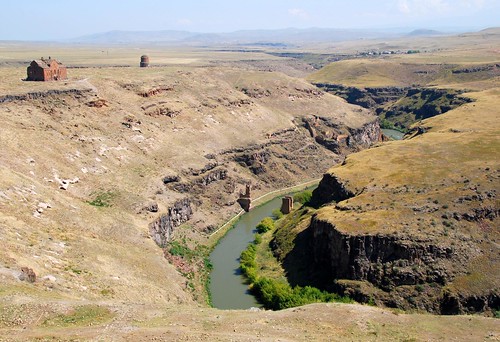
Turkey on the left, Armenia on the right (separated by the Araks River).

Hope framed in the doorway of the Ani Cathedral.
And to answer your question: No, I don’t think we’ve become blasé about amazing sights.
Transportation from Ayder to Kars: First, the bad news: our first bus driver stuffed about 25 people in a van made to seat 15, we had no idea if we would actually make it to Kars due to the language barrier, and our third bus broke down in the middle of nowhere. Twice. Now for the good news: the trip from Ayder to Kars was the most breathtaking bus ride we’ve taken so far on the trip. We traveled from the lush greenery of the Kaçkars’ Black Sea side to the dry, rocky landscape of the south side. And then it was on through verdant pasture lands, mountains with ramshackle stone houses built into their sides, little boys herding cattle through dry, golden steppes, and whole families riding home in donkey carts after a day of working in the field.
Due to MASSIVE CONFUSION as a result of the language barrier in this region, we have no idea how to advise you on getting from Ayder to Kars. Just know that (1) you can do it (we didn’t even know that much before we got on the bus), and (2) it will cost you 55 TL (US$35) each for the entire trip.
Where we slept in Kars: Though the Güngören Hotel (50 TL or US$30 for a double ensuite) is pretty rough around the edges, so is the rest of Kars. It’s not much to look at, but the rooms are pretty big and the staff is nice.
If you’ve been following along, you know by now that Turkey has got it all: a wandering coastline bordering lucid blue waters, a cosmopolitan city wrapped around a chewy historical center, snowy white rock springs so lovely that visitors are moved to strip down to their Speedos (in a Muslim country no less), and a surrealist landscape that would make Dali proud. We saw all these amazing sights in west and central Turkey, so it was time to move to the northeastern corner of the country to check out some good, old-fashioned mountains.
The Kaçkar Mountain Range is a famous trekking area in Turkey. However, Turkish trails, especially in this region, are notorious for being badly signposted. We were strongly advised to find a guide, even for a day hike. But when Jeremy and I researched 3- and 4- day treks through the Kaçkars, we found them to be prohibitively expensive—often over €600 per person! Figuring we would have better luck finding a decently-priced guide once we arrived in the Kaçkars (after all, companies who advertise on the internet are often more spendy), we put ourselves on a bus headed northeast (for more on that saga, read the Transportation section below) and crossed our fingers. The eastern side of Turkey is much less touristed, and information on the area is either scarce or outdated. But everything has always worked out before…why should this time be different? (And this is the point in the movie where you would be screaming, “No! Don’t walk through the door! There’s a monster hiding in there!!!”)
There are two ways you can approach the mountain: on the Black Sea side (in which case a little town named Ayder would be your home base), or via the southern side of the mountain (Yusufeli). Our guide book recommended Ayder as a good place to organize treks, and we had no reason to doubt the LP’s accuracy. (MONSTER!!!!)
We reached Ayder exhausted, hungry, and delirious (17 hours of bus rides will do that to you). And then there was The Hill. See, Ayder’s bus stop sits at the bottom of a long, steep hill…and naturally all the guest houses are a several huffs and puffs from the station.
We were in for more surprises. First of all, Ayder was dead. We could barely find a soul on the street, much less someone to take us up the mountain. Of the few people who we could find, no one spoke English. How exactly are we supposed to find someone to take us hiking?
We literally wandered all over the town of Ayder, trudging up and down the hill, from one place to the next, pantomiming our desire for a mountain guide. After a couple of hours of this, we had downgraded our expectations from “multi-day trek” to “day hike.” Tired, hungry, and frustrated, we gave up for the day and stopped into the closest restaurant for dinner, hoping our hiking plans would miraculously work themselves out by morning. And what do you know? Not only did we find a very sweet family serving amazing home-cooked food, but even better—a couple of Israeli tourists stopped in after completing a 3-day trek and we peppered them with questions about hiking in the Kaçkars. From this we gathered: catch the 10AM bus to Kavrun and organize a trek from there. Success!!!
After a few false starts (the bus leaves at 10AM, no—9AM, no—9:30. Ish.), we take an hour and a half to arrive in Kavrun, even though it is only 30 km away (blame the terrible roads…and the tea stop). This gave us plenty of time to meet other English-speaking travelers on the bus: a German couple, and two Turkish guys.
It’s true: you can find a guide in Kavrun. The Turkish guys got to work trying to negotiate a price for a guide to take all 4 of us up the mountain (the Germans opted out of the hike), but when that price is deemed too high, we decide that we can find our way as a group. What could possibly go wrong with this plan? (The monster—he’s right behind you!!!!)
Long story short: about 3 hours into our trek, the weather turned bad. As in, really bad. As in, rain + fog + thunder + lightning + hail kind of bad. So bad you can’t see 10 feet in front of you kind of bad.

The town of Kavrun, enveloped in fog. This photo was taken 2 minutes after the photo above.
Jeremy and I decided to turn around, but the Turkish guys stubbornly decided to keep looking for our final destination (a group of alpine lakes). Ten minutes after we left them, Jeremy and I found the lakes. Our group had walked right by them on the way up, but the thick fog obscured our view.
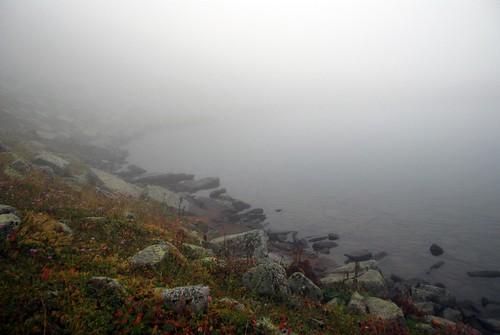
How could we possibly miss this?!?
After a few scary moments of losing the trail in severe weather, J and I finally found the original path and booked it down the mountain as fast as we could. We were cold and soaked to the bone, but we were happy with our decision to turn around.
We finally made it back to Kavrun’s little cafe and joined a group of Israelis and the German couple warming themselves by the fire. And here’s where the story really gets interesting. Turns out the bus driver was waiting for the 4 of us to return from our hike before he was willing to make the drive back to Ayder (perhaps he communicated this to the Turks, but J and I had no idea). The Israelis and Germans had been waiting ALL DAY for us, and were understandably upset about this. But given that this was the only bus back to Ayder, we didn’t want to leave the Turkish guys on the mountain. They weren’t properly dressed and the weather was really bad. So we waited.
And waited.
And waited.
And then we worried. Well, at least Jeremy and I worried. Everyone else was pissed off and wanted to get going. But the bus driver stuck to his guns—he wasn’t going to leave the two Turkish guys stranded in Kavrun without a ride back to Ayder.
More waiting.
Finally, one of the Israeli girls harasses the bus driver long enough that he agrees to leave. We ask the guides at the cafe to go looking for the Turks if they don’t show up before 5PM. On our way out, J and I kept looking out the windows, searching for our lost Turkish friends. We hope they made it back safe.
Transportation from Cappadocia to Ayder: Despite warnings from the bus ticket vendor (we thought he was just trying to close the sale), J and I wait until the day of to buy tickets from Cappadocia to Ayder and find that they are sold out. Note to future travelers of this route: Buy your tickets several days in advance! This is a not a heavily traveled route—there are only 2 bus companies that make the trip each day.
We also found that the Lonely Planet has either outdated or incomplete information on this region. The guidebook said there were direct buses from Rize to Ayder, but after an exhausting overnight bus ride from Cappadocia to Rize, we found (after much pantomiming) that we had to take a local bus to the Rize minibus terminal, catch another bus to Pazar, where we could catch a direct bus to Ayder. Since our original bus from Cappadocia was headed further east, life would have been a lot easier if we just got off the bus in Pazar rather than Rize. Another note to future travelers: don’t blindly trust the Lonely Planet! Always double check the info you get from your guidebook, especially in “off-the-beaten-path” destinations. It could save you a lot of pain and frustration.
All of this travel was during Ramazan. So prior to getting on the bus to Pazar, we bought a kebap, and then proceeded to try to eat said kebap on the bus without any of the locals seeing (it’s rude to eat in front of fasting Muslims). I have never in my life felt so guilty for eating a sandwich.
Where we slept in Ayder: We found a cheap (50 TL for double ensuite), comfortable little family-run place about 2/3 up the hill in Ayder, called something like Uçhisar or Uçhalar Pensiyon (sorry, notes are thin for this region). Can’t say I recommend the place, as the showers were not hot. There’s nothing like taking a lukewarm shower after getting drenched in the Kaçkars. Can’t say I recommend that, either.
